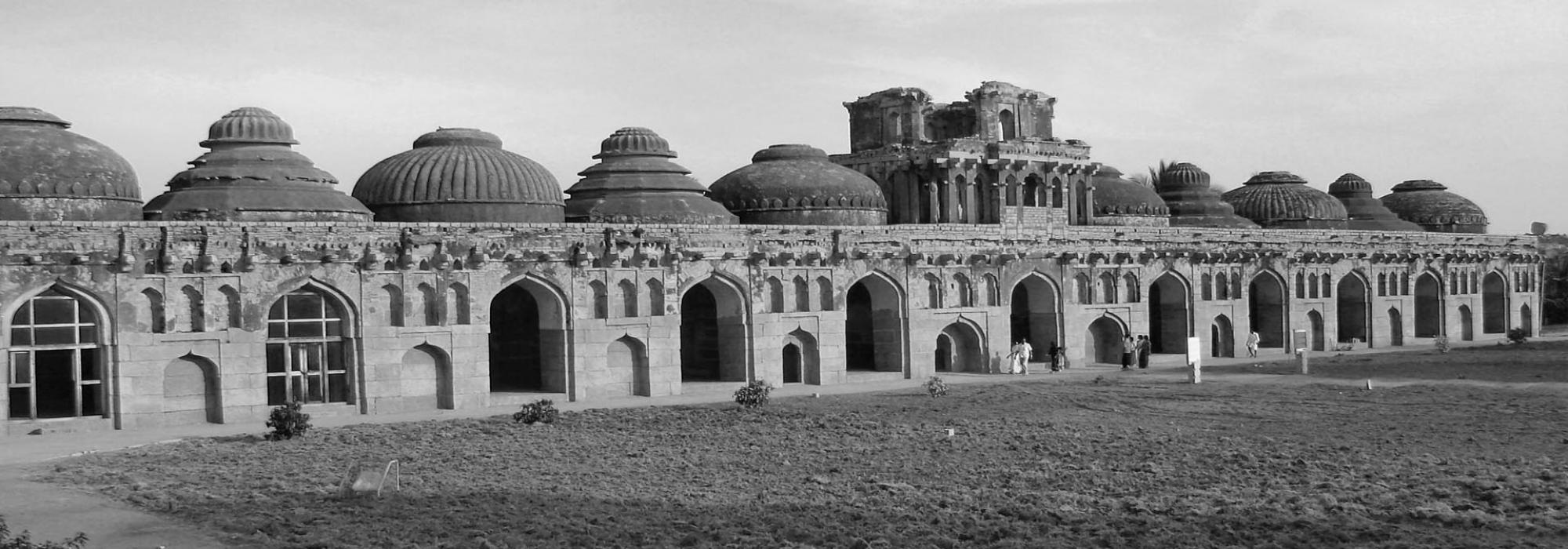Malik Kafur came to Devagiri, which was at the forefront of South India. Ramachandra was the king of that region. Initially, all of Malik Kafur's ruthless attacks bore no fruit. However, in his second battle with Ramachandra, Malik Kafur defeated him using deceit and foul-play. Soon after, he came to Kapilaraya's Anegondi. Even there, there was widespread bloodshed. Then he attacked Ballala III, a weak Hoysala king who was ruling over Dvarasamudra (Halebidu). When Malik Kafur attacked Dvarasamudra, Ballala III was away at Thiruchanapalli. The whole of Dvarasamudra was razed to the ground. Soon after that, Malik Kafur came to Thiruchanapalli. Srirangam, which is close by, was washed in the blood of Hindus. Then he attacked Madurai and looted the Meenakshi temple and the Sundareshvara (Sokkanatha) temple. He then went to Rameshwaram and had a mosque built there. In spite of all this ruthlessness, pillaging, murder, and bloodbath he was unable to hold on to all those places for long. When we see the numbers and figures that historians give us, we are wont to get awe-struck; he took away the loot on the backs of two thousand elephants and three thousand camels. Several of the 'secular' scholars wax eloquent that it was merely the attraction of such wealth that the Muslims went on invasions and not with a view to harm or convert. But that is all a bunch of lies and self-deception. Women, wealth, land, and religion – all these four were sought after by all Muslim rulers.
The Vijayanagar Empire was born to oppose all this [such inhuman acts of the Muslims against the Hindus]. It was a heightened expression of the values of Sanatana Dharma. When the Muslims constantly invaded various parts of India, although for various reasons we were unable to oppose them as a whole, we successfully resisted them (and defeated them) in parts. Several kings bravely opposed the onslaught of the wicked invaders. In South and Central India, wherever the Muslims invaded, the Hindus later rebuilt their kingdoms. But we were unable to strike at their strategic spots and destroy them at a fundamental level. Not only that, they didn't harbor even the thought of re-converting the Muslim fighters back to Sanatana Dharma. In fact, anyone can become a Hindu by the simple procedure of a vratyahoma. This is well-known even from Vedic times but even so, our people failed to use it. Not building the Hindu population methodically and by using various means was a huge mistake of our people.
The Vijayanagara Empire, which strode with unparalleled magnanimity and legendary brilliance, fell during the reign of Aliya (son-in-law) Ramaraya, in the historic Battle of Rakksangadi (also called the Battle of Talikota) in 1565. Such a ghastly war had never been fought in the history of South India. According to some accounts, this war was waged for months together. According to a few other accounts, it was finished in a few days. Ramaraya was the son-in-law of Krishnadevaraya and by fair standards a capable ruler. But he had the habit of entering regions ruled by Muslims at whim. He also had Muslim friends. The various Muslim provinces in Central India like Ahmadnagar, Birar, Bidar, Gulbarga, Bijapur, Golconda, etc. were constantly fighting amongst themselves. Every now and then, the Vijayanagara Emperor would take sides with one of these Muslim provinces; else it would play accusatory political blame-games. Historians say that Ramaraya engaged in such political games as part of his strategic vision. When his relations with the Portuguese worsen, he first tried to sort it out diplomatically and when that failed, he waged war against them; he defeated them and extorted a hundred thousand pagodas from them. Therefore, although he was strong and capable, he was not particularly effective when it came to strategy. He was not able to recognize where the real difficulty lay. The biggest blunder he did was to repose faith in Muslim commanders of his army. There are several examples to show that one's religion drives one to be unjust and engage in fraudulent acts. Of course, there may also be a few instances when one's religion drives on to be just. But in the case of Islam, Muslims have always treated non-Muslims unjustly, everywhere and at all times; and the adherents of Islam always believe that whatever they do is the true justice.
The Muslim historian Ferishta accuses Ramaraya of disrespecting Muslim women. When he had Muslim friends, he might have also had Muslim women. This might have happened as a peripheral issue. But this is surely not the main contention. The main reason for the fall of the Vijayanagara Empire is the ganging up of all Islamic forces in Southern India with a sole view to defeat this resplendent Hindu Empire.
Caesar Frederick, a foreigner historian (who was an eyewitness) says that during the time of war, two of Ramaraya's generals escaped to the enemy camp. The number of soldiers who went along with them to the enemy camp was easily between hundred thousand and hundred-and-fifty thousand. This brought a huge disaster on the Vijayanagara soldiers. A situation arose where they wanted to run away without fighting. And several of them died fighting as well.
Ali Adil Shahi, the Bahmani king had promised Ramaraya that he would remain neutral if a war erupted but ended up siding with his Muslim brothers. This [neutrality of Ali Adil Shahi] was merely a strategy of the enemies of Ramaraya.

















































